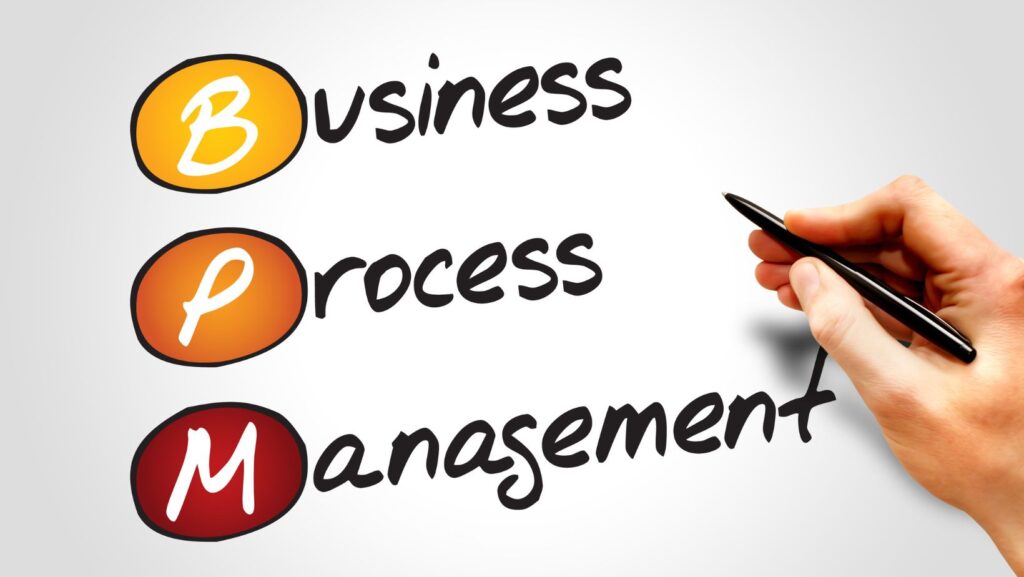Navigating Business Process Management (BPM): A Roadmap

Business Process Management (BPM) is a strategic approach to business operations that has altered the way businesses operate.
This methodology is a systematic and holistic approach to streamlining an organization’s workflow, making it more efficient, effective, and adaptive to a changing environment.
It is a complete strategy that entails a number of tasks such as business process design, execution, monitoring, and optimization.
These processes are a set of interconnected tasks that result in the delivery of a product or service to a customer.
They are an organization’s lifeblood, influencing the rhythm and pace at which it runs. BPM plays a critical role in a dynamic business landscape by helping businesses to streamline their operations, improve efficiency, and quickly respond to changing market trends.
The conductor orchestrates a business’s symphony of responsibilities, ensuring that each component plays in unison to produce a tune that resonates with success.
What is BPM?
BPM is an operations management discipline that employs a variety of techniques to uncover, model, analyze, monitor, improve, optimize, and automate complex business processes.
It connects business operations (what happens) with business requirements (what should happen).
It is the purposeful, collaborative, and increasingly technology-assisted definition, improvement, innovation, and administration of end-to-end business processes that generate business results, create value, and allow a company to accomplish its business objectives with more agility.
It enables a corporation to align its business processes with its business strategy, resulting in improved overall company performance through improvements in specific work activities within a department, across the enterprise, or between companies.
Decoding the BPM Strategy

A BPM strategy is a thorough plan outlining how a company will use concepts to improve its processes.
Identifying corporate objectives, establishing processes to enable their achievement, implementing these processes, assessing their effectiveness, and refining them for superior results are all part of this strategy.
A well-crafted BPM strategy acts as a road map that directs the organization toward its objectives.
It guarantees that all business operations are linked with the organization’s strategic goals, ensuring that every activity contributes to these goals being met.
This alignment is critical because it prevents resources from being squandered on activities that do not contribute to strategic goals.
The BPM strategy is a living document that changes in response to the changing business environment.
It is updated on a regular basis to reflect changes in corporate goals, market conditions, and organizational capabilities.
This guarantees that the strategy is still relevant and effective in directing the firm toward its objectives.
The BPM Lifecycle: A Continuous Cycle of Improvement
The BPM lifecycle is a continuous cycle of improvement that consists of five stages
Design: This is the foundational stage where the processes that need to be managed are identified. It involves understanding their current state, defining the desired state, and outlining the steps required to transition from the current to the desired state. This stage requires a deep understanding of the organization’s operations and a clear vision of what needs to be achieved.
Model: Once the processes are designed, they are represented visually using flowcharts or diagrams in the modeling stage. This visual representation aids in better understanding of the processes and helps identify potential issues or bottlenecks that may hinder process execution.
Execute: The execution stage involves implementing the designed processes. This may involve using software or other tools to automate the processes, thereby reducing manual intervention, and increasing efficiency.
Monitor: The monitoring stage involves continuously tracking the performance of the processes to ensure they are achieving the desired results. Key performance indicators (KPIs) are used to measure process performance, providing valuable insights into the effectiveness of the processes and highlighting areas that need improvement.
Optimize: The optimization stage is where the real value of the BPM lifecycle is realized. Based on the insights gained from monitoring, the processes are refined and optimized for better performance. This may involve making changes to the process design, execution methods, or even the underlying business rules.
Best Practices in Business Process Management

Implementing BPM in an organization involves following certain best practices.
These practices are derived from the experiences of successful organizations and provide a guideline for achieving success.
- Clear goals and objectives: The goals and objectives of each process should be clearly defined and aligned with the organization’s strategic goals. This ensures that every process contributes to the overall success of the organization.
- Stakeholder involvement: BPM is not just a management initiative but a collaborative effort that involves all stakeholders, including employees, management, and customers. Their feedback and suggestions can provide valuable insights for process improvement.
- Process documentation and analysis: Detailed documentation and analysis of all processes are crucial for successful BPM. This helps in identifying bottlenecks, inefficiencies, and areas for improvement.
- Use of process modeling techniques: Visual representation of processes using modeling techniques such as flowcharts and Business Process Model and Notation (BPMN) can aid in better understanding and communication of the processes.
- Continuous monitoring and measurement of process performance: Regular monitoring and measurement of process performance using KPIs can help in identifying issues early and taking corrective action.
- Use of technology for automation and optimization: Software and other tools can be used to automate and optimize the processes, leading to increased efficiency and reduced errors.
- Fostering a culture of continuous improvement: An organization should foster a culture where continuous improvement of processes is encouraged. This helps in keeping the processes up-to-date and efficient and ensures that the organization remains competitive in a rapidly changing business environment.
Benefits of Business Process Management

The implementation of BPM can yield a multitude of benefits for an organization:
Efficiency and productivity gains: Streamlining and automating processes, and can lead to significant efficiency and productivity gains. This can result in cost savings and increased profitability.
Improved quality of products and services: Can help in reducing errors and improving the quality of products and services. This can enhance customer satisfaction and lead to increased customer loyalty.
Enhanced responsiveness to market changes: Enables organizations to quickly adapt their processes in response to changing market conditions. This agility can provide a competitive advantage in a rapidly changing business environment.
Facilitation of digital transformation: Plays a key role in digital transformation by enabling organizations to automate and optimize their business processes. This can enhance operational efficiency and enable the organization to deliver superior customer experiences.
Types of Business Process Management

BPM can be categorized into three main types, each with its unique focus and application:
- Integration-centric: This type integrates various systems and applications in an organization. It is particularly useful for processes that involve a lot of data exchange between different systems.
- Human-centric: This type focuses on processes that are primarily executed by humans. It provides tools for task management, collaboration, and workflow management, thereby enhancing the efficiency and effectiveness of human-centric processes.
- Document-centric: This type is used for processes that revolve around documents. It provides features for document management, including version control, access control, and document routing, thereby enhancing the efficiency and effectiveness of document-centric processes.
Technologies and Tools
There are various BPM technologies and tools available that can help in implementing BPM in an organization.
These tools provide features such as process modeling, workflow automation, task management, and performance monitoring.
Some popular tools:
These tools can significantly enhance the efficiency and effectiveness of business processes, thereby contributing to the overall success of the organization.
Action Item List: BPM For a Small Business

Conduct a Process Audit: Start by conducting a comprehensive audit of all your existing business processes. Document each process, noting down the steps involved, the time taken, the resources used, and the individuals or teams responsible. This will give you a clear picture of your current operations and help you identify areas that need improvement.
Deliverable: A detailed process audit report.
Identify Improvement Opportunities: Analyze the process audit report to identify bottlenecks, inefficiencies, or areas where errors frequently occur. Prioritize these areas based on their impact on your business operations and goals.
Deliverable: A list of prioritized improvement opportunities.
Define Clear Objectives: For each improvement opportunity, define clear, measurable objectives. These could be reducing the time taken for a process, decreasing error rates, improving customer satisfaction, or any other relevant business goal.
Deliverable: A set of clear, measurable objectives for each improvement opportunity.
Select a Tool: Research various BPM tools available in the market. Consider factors such as cost, ease of use, features, scalability, and compatibility with your existing systems. Choose a tool that best fits your business needs and budget.
Deliverable: Selection of a suitable BPM tool.
Redesign Processes: Use your chosen tool to redesign the identified processes. Ensure that the new processes align with your business goals and are streamlined for efficiency.
Deliverable: Redesigned process maps or flowcharts.
Develop a Training Program: Develop a comprehensive training program to familiarize your team with the new processes and the BPM tool. The training should cover the rationale behind the new processes, the steps involved, the use of the BPM tool, and the expected outcomes.
Deliverable: A comprehensive training program and materials.
Implement the New Processes: Roll out the new processes gradually. You might want to start with a pilot program involving one team or department, before implementing it across the organization. This allows you to test the new processes, make necessary adjustments, and ensure a smooth transition.
Deliverable: Successful implementation of new processes in a pilot program.
Monitor Performance: Use the monitoring and analytics features of your BPM tool to track the performance of the new processes. Regularly review key performance indicators (KPIs) to ensure that the processes are meeting the defined objectives.
Deliverable: Regular performance reports showing progress against objectives.
Iterate and Improve: Based on the performance reports, identify areas where further improvements can be made. Make necessary adjustments to the processes and continue monitoring their performance. This iterative approach ensures continuous improvement and adaptation to changing business needs.
Deliverable: Ongoing process improvement and adaptation.
Foster a Culture of Continuous Improvement: Encourage your team to embrace the new processes and to continuously look for ways to improve them. Recognize and reward those who contribute to process improvement. This will help foster a culture of continuous improvement, which is key to the long-term success.
Deliverable: A culture of continuous improvement within the organization.
Establish Governance Structure: Create a team or assign a person responsible for overseeing the BPM initiative. This could be a process owner, a BPM manager, or a cross-functional team. They will be responsible for ensuring the adherence to the new processes, resolving any process-related issues, and driving the continuous improvement efforts.
Deliverable: A BPM governance structure with clearly defined roles and responsibilities.
Communicate Regularly: Keep all stakeholders informed about the progress of the initiative. Regular communication helps to maintain engagement, manage expectations, and ensure that everyone is on the same page. Use various communication channels such as meetings, emails, newsletters, or an intranet portal.
Deliverable: A communication plan and regular updates to all stakeholders.
Evaluate the Impact: After a certain period of implementing the new processes, evaluate the impact of BPM on your business. Look at the key performance indicators (KPIs) and compare them with the objectives you set at the beginning. This evaluation will help you understand the effectiveness of your BPM initiative and identify areas for further improvement.
Deliverable: An evaluation report showing the impact of BPM on your business.
Plan for Future Process Improvements: Based on the evaluation, plan for future process improvements. This could involve refining the existing processes, extending the BPM initiative to other processes, or upgrading your BPM tool. Remember that BPM is a continuous journey of improvement and adaptation to changing business needs.
Deliverable: A plan for future process improvements.
Implementing BPM is a significant change initiative that requires time, effort, and commitment.
The potential benefits in terms of improved efficiency, effectiveness, and agility make it a worthwhile investment for any small business aiming to grow and succeed in today’s competitive business environment.
Final Thoughts

Business Process Management is more than a set of tools or a methodology.
It is a philosophy that infuses an organization with a commitment to excellence, a dedication to continuous improvement, and a resolve to deliver the best.
With relentless change and competition, BPM serves as a guiding light, illuminating the path to success and providing a blueprint for the future.
As we look to the future, we are reminded of the words of Alan Kay, “The best way to predict the future is to invent it.”
It is more than just a discipline, a methodology, or a technology. It is a philosophy, a mindset, and a way of life.
A commitment to excellence, a dedication to improvement, and a resolve to deliver the best.
In a world of relentless change and relentless competition, it is a pathway to success, and a blueprint for the future.
FAQ
Q: What is Business Process Management (BPM)?
A: Business Process Management (BPM) is a strategic approach to streamlining an organization’s workflow, making it more efficient, effective, and adaptable to a changing environment. It entails a number of actions such as business process design, execution, monitoring, and optimization.
Q: What is the BPM strategy?
A: A BPM strategy is a thorough plan outlining how a business will use BPM concepts to improve its processes. Identifying corporate objectives, establishing processes to enable their achievement, implementing these processes, assessing their effectiveness, and refining them for greater outcomes are all part of this strategy.
Q: What are the stages of the BPM lifecycle?
A: The BPM lifecycle consists of five stages: Design, Model, Execute, Monitor, and Optimize. Each stage plays a crucial role in ensuring the effectiveness and efficiency of business processes.
Q: What are some best practices in Business Process Management?
A: Setting clear goals and objectives, involving stakeholders, documenting and analyzing processes, using process modeling techniques, continuously monitoring and measuring process performance, using technology for automation and optimization, and fostering a culture of continuous improvement are some best practices in BPM.
Q: What are the benefits of Business Process Management?
A: BPM can lead to increased efficiency and productivity, higher product and service quality, greater marketplace responsiveness, and the facilitation of digital transformation.
Q: What are the different types of Business Process Management?
A: BPM can be categorized into three main types: Integration-centric BPM, Human-centric BPM, and Document-centric BPM. Each type focuses on a different aspect of business processes and has its unique applications.
Q: What is the future of Business Process Management?
A: With breakthroughs in technology such as artificial intelligence (AI), machine learning, and blockchain, the future of BPM is bright. These technologies have the potential to further automate and optimize company processes, resulting in increased efficiency and lower costs. Businesses’ increased adoption of digital transformation methods is projected to drive future demand for BPM.
Bio

Ronnie Patterson
Ronnie Patterson, founder of MagnÜron, is a multifaceted entrepreneur with a diverse background in music, electronics engineering, and engineering management. Drawing on experience across various industries, He offers expertise in SEO, operations, and strategy to help businesses thrive. Possessing a unique perspective and unwavering commitment to collaboration, and ideal partner for growth and success.






